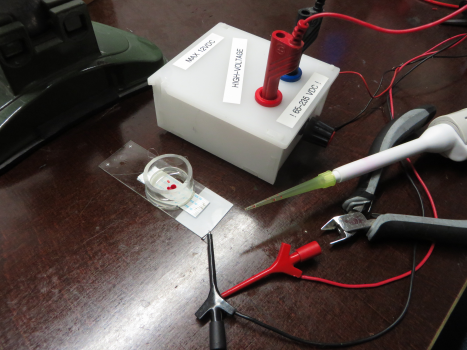Difference between revisions of "Elektrowetting"
From Hackteria Wiki
(→DIY experiment) |
|||
| Line 36: | Line 36: | ||
{{#widget:Iframe | {{#widget:Iframe | ||
|url=http://www.youtube.com/embed/eD0h2jBZXCI | |url=http://www.youtube.com/embed/eD0h2jBZXCI | ||
| − | |width= | + | |width=500 |
|height=300 | |height=300 | ||
|border=0 | |border=0 | ||
| Line 42: | Line 42: | ||
[[File:Electrowetting_DIY_setup.png|x350px]]<br> | [[File:Electrowetting_DIY_setup.png|x350px]]<br> | ||
| − | |||
== References == | == References == | ||
Revision as of 11:38, 1 December 2014
Introduction
- Electrical charge of the surface changes the shape of water drops (before 1875)
- Electrowetting is the modification of the wetting properties of a surface by applying different electric fields (1981)
- "fluid transistor" for manipulating chemical and biological fluids (1980)
- Electrowetting on this dielectric-coated surface, EWOD (1993)
- Digital Microfluidic Circuits
What you need:
- insulating dielectric and hydrophobic layers
- immiscible fluids
- DC or RF power
- mass arrays of miniature interleaved electrodes (Indium tin oxide (ITO))
- digital control
- nano droplets
What you can do:
- move droplets in linear, circular and directed paths
- pump fluids
- mix fluids
- fill reservoirs
- move droplets over sensors or heaters
- control fluid flow electronically or optically
source: http://en.wikipedia.org/wiki/Electrowetting
DIY experiment
What you need:
- ribbon cable
- water, oil
- high voltage
What you can do:
References
On chip Sample preparation utilising EWOD Concept
DNA Lab on a Chip
Sandia Digital Microfluidic Hub
The Electrowetting Display
